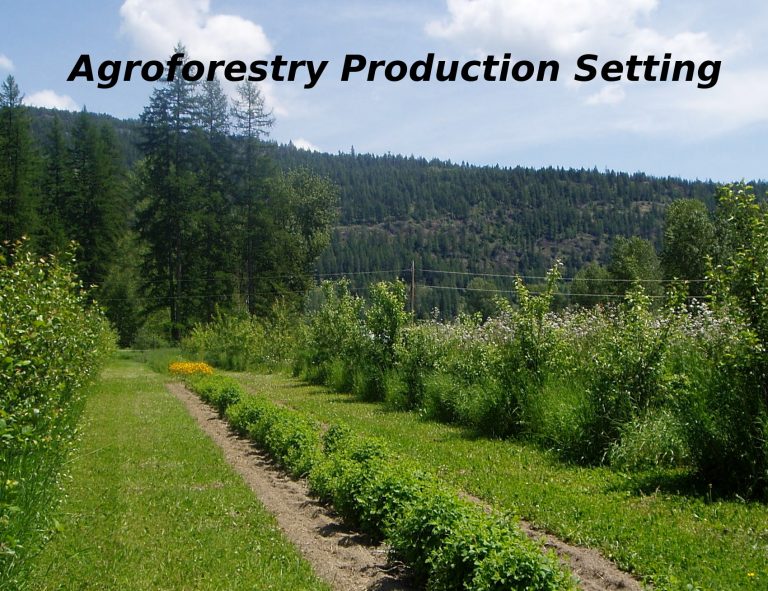Getting Started in Agroforestry: Part 4, Production Setting
by George Powell
What can I grow here? I field inquiries related to the agroforestry production setting, more than any other. And, without doubt, if you can’t grow it you can’t sell it.
A more refined approach however, should be to ask, “What can I grow that will sell?” And, “What can I grow within my financial capacity?”.
With those questions answered first, you should have a short-list of crops or livestock of interest. More homework is now in order. Time to explore if you have a suitable growing environment, and the necessary infrastucture, equipment and other resources in place. You will also need to start the process of investigating your production system at the same time.
Let’s Get Bio-Physical
Assessing your agroforestry production setting starts by understanding the biophysical.
All plants, animals, fungi and other life have a range of conditions in which they can survive. And their adaptation, or ecological potential, is governed by a host of factors. These include the range of temperatures, frost-free period, solar input, rainfall and soils.
Any livestock you will likely consider will have a wide enough adaptation to fit within most settings. That is, as long as you attend to providing sufficient water, shade and other animal welfare concerns.
For trees, shrubs and other crops, adaptation is encapsulated in plant hardiness zones. These rating systems in use in Canada and US match different plant crops to the broad patterns of climate.
There are, however, some important additional things to consider:
Survive vs Thrive
The plant hardiness zones do not differentiate between the ability to survive in a given area, versus growing well. You want your crops to develop, bear fruit and mature, not just live.
Hardiness Zones do not Consider Microclimates
Topography, variations in rainfall and other climate differences exist at a small scale. And they matter. As a result, microclimates may make your agroforestry production setting more, or less suited to a given crop.
Modifications
Water deficits can be overcome with irrigation. And, topography and soils can be modified and used to overcome temperature or moisture limitations. Shade cloth can help young plants survive in the open. In other words, if the cost-benefit makes sense, limitations can be overcome with inputs.
Agroforestry is itself an act of modifying the light, water availabilty, temperature and humidity in the understory. And, as an agroforestry system matures, the trees and shrubs will become a significant factor influencing the site. You may however, need to ‘nurse’ new crops along until those changes occur. Alternately, you can rotate your intercrop choices through time as the microclimate changes.

Is it Just Me or is it Getting Hot in Here?
Planning and planting in the midst of a changing climate makes your crop screening job a bit more difficult.
With very long-lived tree and shrub crops, you need to consider beyond today’s suitability. Depending on your production goals, you may be trying to match the climate of 10, 20 or 100 years from now.
Planting for yesterday’s potential can result in failure. As can jumping too far ahead into the climate change projections.
Infrastructure and Other Resources
An evaluation of the agroforestry production setting should also consider the availability of key infrastructure or specialty equipment. This links back to the financial planning step. And it may take a few planning iterations to find the right crop and livestock combinations to match your resources.
Human resources should also be examined in the same context. What is your capacity to take on seasonal work loads? What are the efficiencies and risks associated with this production setting.
For example, let’s look at a situation where you need to irrigate to ensure crop survival. Can your investments in equipment and your labour pool accomplish this new work if it overlaps with other mission-critical work in the summer? Diversify, don’t diworseify.
Regulations
Rules were not made to be broken. That is, not if you want to stay in business.
You will need to do a thorough investigation of your location in light of the applicable regulations. This includes everything from your ability to access water, required setbacks, mandatory plant and animal health standards, work windows for water developments or spreading fertilizer. Etcetera, etcetera.
You might want to implement that neat ‘key line’ system on your farm. And use it to slow the water movement through your agroforestry planting. But, you may run into a regulatory wall in some jurisdictions where it is not legal to change the path of a water course.
Take advantage of programs such as the Environmental Farm Plan Programs across Canada. This will provide you a thorough overview of your regulatory setting.
Subscribe via RSS
